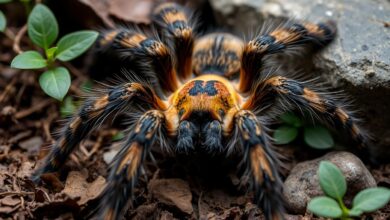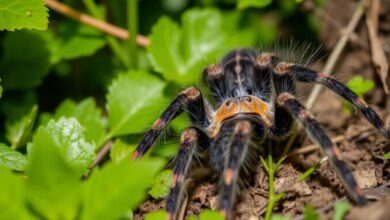Tarantula Breeding
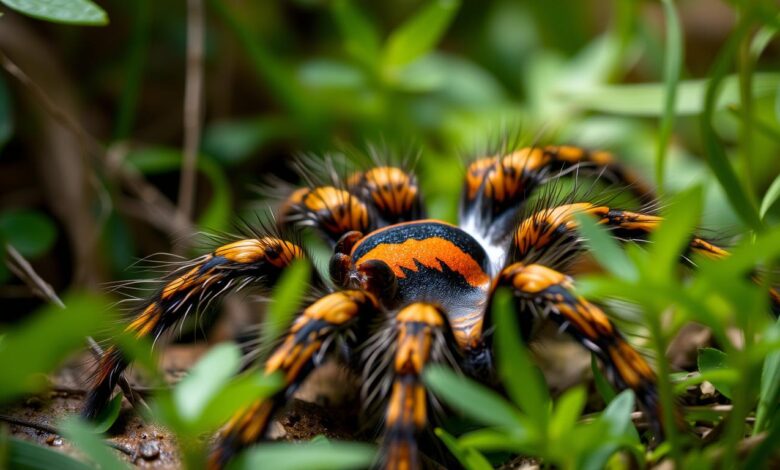
Tarantula breeding is a fascinating hobby that lets enthusiasts learn about arachnid reproduction. This guide covers everything from their mating habits to the challenges and ethics of breeding them. It’s perfect for both experienced hobbyists and those just starting out. You’ll get all the info you need to understand tarantula reproduction, spider mating, and arachnid reproduction.
We’ll take you through the steps of tarantula breeding, from courtship to raising spiderlings. You’ll learn how to set up the right breeding space and keep your spiders healthy. It’s a journey into the world of tarantulas that’s both interesting and rewarding.
If you’re curious about the science of tarantula breeding or just want a new hobby, this article is for you. It gives you the knowledge and tools to become a skilled tarantula breeder. Let’s dive into the world of tarantula reproduction together and see what it has to offer.
Understanding Tarantula Reproductive Behavior
Tarantulas have fascinating ways of reproducing, from complex courtship rituals to beautiful mating dances. These behaviors are key to breeding them and understanding their lives.
Courtship Rituals and Mating Dances
Tarantulas have special courtship rituals. They wave their legs, tap their abdomens, and even touch gently. These actions help attract mates and show the male’s health and intentions. The mating dances of male tarantulas are stunning, as they dance around the females.
Identifying Male and Female Tarantulas
It’s important to know the difference between male and female tarantulas for breeding. You can tell them apart by their looks. Look at the pedipalps near their mouths and the hairs on their abdomens.
| Physical Characteristic | Male Tarantula | Female Tarantula |
|---|---|---|
| Pedipalps | Larger and more swollen | Smaller and less pronounced |
| Urticating Hairs | Typically less prominent | Often more prominent on the abdomen |
| Size | Generally smaller in body size | Typically larger in body size |
Learning about tarantula reproductive behavior, courtship rituals, and mating dances helps you understand these amazing arachnids. Knowing the differences between male and female tarantulas makes it easier to work with them.
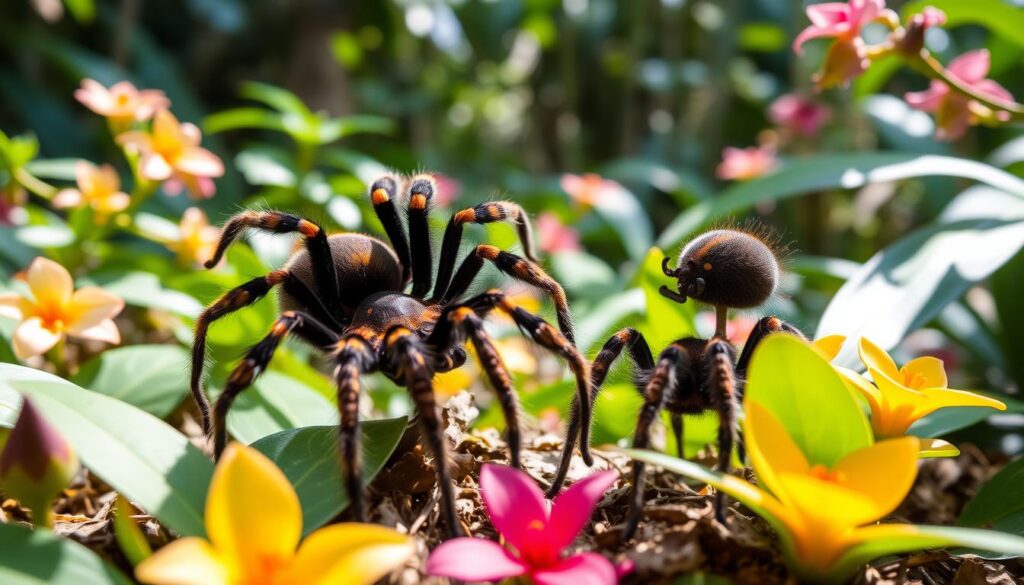
Preparing for Tarantula Breeding
Successful tarantula breeding needs careful planning and attention to the breeding enclosure. It’s important to create the right environment for your tarantulas to mate and lay eggs. You must plan everything from temperature and humidity to substrate selection carefully.
Setting Up a Breeding Enclosure
When setting up a breeding enclosure for your tarantulas, think about these things:
- Temperature: Keep the temperature steady, between 70-80°F (21-27°C). This mimics the natural conditions tarantulas love.
- Humidity: The enclosure should have humidity of 60-80%. This matches the humid places tarantulas live in.
- Substrate: Pick a substrate that keeps moisture well, like peat moss and vermiculite or coco fiber. It helps keep humidity right.
- Hiding Spots: Add plenty of hiding spots, such as cork bark or plastic hides. This lets the tarantulas feel safe and comfy during mating.
- Ventilation: Make sure the enclosure has good airflow. This prevents bad air from building up and keeps the environment healthy.
| Breeding Enclosure Requirements | Optimal Conditions |
|---|---|
| Temperature | 70-80°F (21-27°C) |
| Humidity | 60-80% |
| Substrate | Peat moss and vermiculite or coco fiber |
| Hiding Spots | Cork bark or plastic hides |
| Ventilation | Adequate airflow |
By thinking about these important factors, you can make a breeding enclosure that’s perfect for your tarantulas. This setup helps them mate and lay eggs successfully.
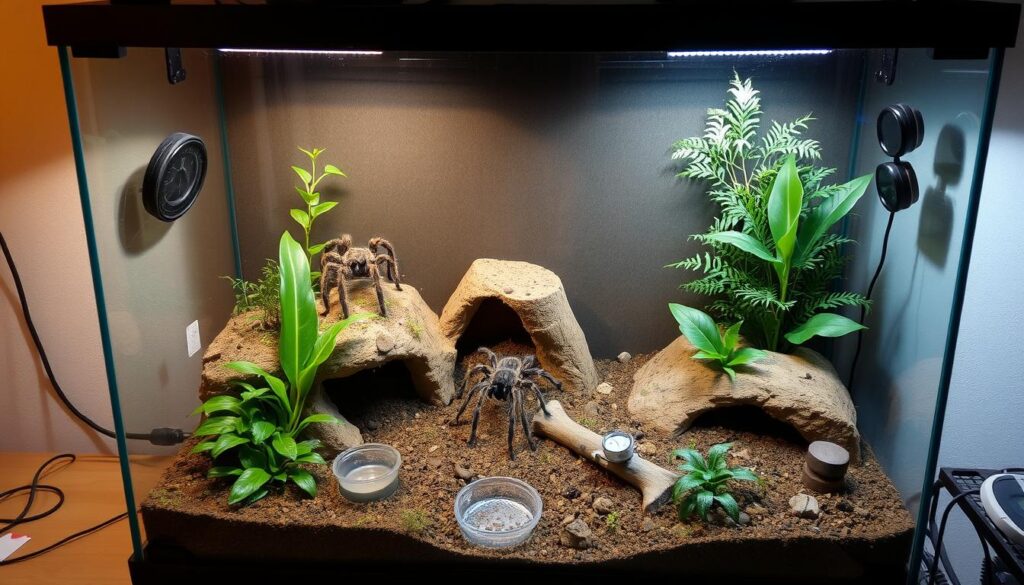
The Mating Process: Spermathecae Transfer
The mating of tarantulas is a complex event, highlighted by a unique process called spermathecae transfer. In this ritual, the male uses his modified pedipalps to put sperm directly into the female’s spermathecae. This special organ stores the sperm for later use in fertilizing eggs.
The tarantula mating process is both delicate and precise. The male starts by vibrating his abdomen and waving his legs to signal the female. Once she’s ready, he carefully places himself and uses his pedipalps to put the sperm into her spermathecae. This pouch is made to keep the sperm safe until the eggs are ready.
After the spermathecae transfer, the tarantula’s reproductive cycle is a big step forward. Knowing how this process works helps breeders and fans of these spiders. It also helps in the conservation and appreciation of these amazing creatures.
| Statistic | Value |
|---|---|
| Described and valid spider species | Over 52,000 |
| Mygalomorph spider species | Approximately 3,000 |
| Theraphosidae (tarantula) species | Over 1,100 |
| Extant Theraphosidae subfamilies | 13, with 1 extinct |
| Global tarantula research distribution | North America, South America, Europe, Africa, Asia, Australia |
Egg Sac Incubation and Care
After mating, the female tarantula makes an egg sac. It’s important to take good care of it for the eggs to grow and hatch well. Keeping the right temperature and humidity is key. If these levels change, it can harm the egg sac.
Maintaining Optimal Temperature and Humidity
Egg sacs need a special balance of temperature and humidity. The best temperature for them is between 70-80°F (21-27°C). If the temperature goes off this range, the baby spiders might not grow or could die.
Humidity is also crucial, and it should be between 70-90%. This keeps the egg sac from drying out. Without enough moisture, the eggs won’t hatch. To keep humidity right, you can mist the enclosure or use a device that controls humidity.
| Ideal Conditions for Tarantula Egg Sac Incubation | Typical Range |
|---|---|
| Temperature | 70-80°F (21-27°C) |
| Humidity | 70- |
Spiderling Dispersal and Raising
When tarantula spiderlings come out of their egg sac, they start a key part of their life – dispersal. This means they spread out and find their own places to live. Taking care of these young spiders is very important for their survival and growth.
The way tarantula spiderlings spread out is quite interesting. Right after they hatch, they move away to find their own spots to hide and eat. This helps them avoid fighting over resources and helps the species survive. But, they are also very fragile and need someone to watch over them.
- Providing the right environment: Make a home for the tarantula spiderlings with the right kind of ground, places to hide, and the right amount of moisture.
- Feeding and hydration: Give them a mix of small bugs and fruit flies to eat, and make sure they have water to drink.
- Monitoring growth and development: Watch the spiderlings for signs of when they need to shed their skin, how they’re growing, and if they’re sick or stressed.
- Minimizing disturbances: Don’t touch or bother the spiderlings too much, as it can stress them out and hurt their growth.
By knowing what tarantula spiderling dispersal needs and taking good care of them, breeders help these young spiders grow into strong adults. This hard work and careful attention are key to keeping these amazing creatures around for a long time.
Tarantula Reproduction: A Comprehensive Guide
Exploring tarantula reproduction is an exciting journey for arachnid fans. This guide covers the main parts of the tarantula life cycle, from courtship to caring for spiderlings. Understanding tarantula reproduction helps you appreciate these creatures more and succeed in breeding them in captivity.
At the core of tarantula reproduction are their courtship and mating rituals. Males perform captivating dances to attract females. It’s key to know how to tell males and females apart for breeding. Creating the right breeding space with the right temperature, humidity, and substrate is vital for their well-being.
Mating is a complex process. The male transfers sperm to the female’s body. This ensures the eggs will be fertilized, starting the next stage of the cycle.
- Egg Sac Incubation and Care: After the female lays her eggs, incubation starts. Keeping the right temperature and humidity is key for the eggs to grow healthy.
- Spiderling Dispersal and Raising: When spiderlings come out, they face new challenges. It’s important to provide the right care for them to grow and thrive.
Learning about tarantula reproduction helps enthusiasts breed them successfully and manage populations responsibly. This knowledge deepens our respect for these spiders and aids in their conservation.
Molting Cycles and Their Impact on Breeding
Tarantula breeding is a complex process that needs a deep understanding of their life cycle. Molting, or shedding their skin, is a key part of their growth. These cycles affect breeding and a healthy molt is key for reproduction.
Fostering a Healthy Molt for Successful Reproduction
Tarantulas molt to grow and get rid of their old skin. This process can be tough for them and might affect their ability to reproduce. To help breeding, it’s vital to create the right environment for molting. This means keeping the right temperature, humidity, and substrate in the enclosure.
- Provide a suitable substrate that retains moisture and allows the tarantula to burrow, which can help facilitate a successful molt.
- Regulate the temperature and humidity levels in the enclosure to mimic the tarantula’s natural habitat, as these environmental factors play a crucial role in the molting process.
- Closely monitor the tarantula’s behavior and physical changes during the molting cycle to identify any potential issues and intervene if necessary.
Creating a healthy molt in your tarantulas boosts the chances of successful breeding. It also keeps your arachnids healthy.
| Molting Cycle Impact on Breeding | Key Considerations |
|---|---|
| Timing of Molting | Ensure that tarantulas are not undergoing a molt during the critical breeding period, as this can disrupt the mating process. |
| Reproductive Readiness | A successful molt can indicate that the tarantula is physically ready for breeding, with a newly hardened exoskeleton and replenished energy reserves. |
| Sperm Storage | Females of certain tarantula species can store sperm from multiple matings, making it essential to monitor their molting cycles to time breedings effectively. |
Understanding how molting cycles and breeding are connected helps you create the best conditions for reproduction. This ensures the health and survival of your tarantulas over time.
Tarantula Husbandry for Optimal Breeding
Proper tarantula husbandry is key for breeding success. It means keeping the right housing, feeding, and environment for the tarantulas. By focusing on tarantula husbandry, breeders boost the chances of getting good breeding results.
Keeping the right humidity and temperature is crucial for optimal breeding conditions. Different tarantula species need specific conditions. By watching and adjusting the enclosure’s climate, breeders make sure the tarantulas are happy and ready to breed.
- Provide a suitable substrate that retains moisture and allows for burrowing, such as sphagnum moss or coconut fiber.
- Ensure adequate ventilation to prevent stagnant air and mold buildup.
- Utilize heating devices, such as under-tank heaters or overhead lamps, to maintain the appropriate temperature range.
A good diet is also key for tarantula health and breeding. Feed them a mix of crickets, roaches, or mealworms. Add calcium and vitamins as they need them.
| Aspect | Ideal Conditions |
|---|---|
| Temperature | 75-85°F (24-29°C) |
| Humidity | 60-80% |
| Substrate | Sphagnum moss or coconut fiber |
| Feeding | Varied prey, calcium and vitamin supplements |
By keeping the best tarantula husbandry conditions, breeders help their tarantulas breed naturally and stay healthy. This leads to better breeding results.
Arachnid Life Cycle: From Spiderlings to Adulthood
Tarantulas and other arachnids go through a fascinating life cycle. They start as tiny spiderlings and grow into the adults we admire. Knowing about these stages is key for breeding and caring for tarantulas.
Tracking Growth and Development Stages
Arachnids, including spiders, have a unique growth journey. They start as tiny spiderlings, small versions of adults. Then, they molt several times, shedding their skin to grow bigger and change.
Each molt moves the spiderling closer to being an adult. It brings big changes in size and behavior. Watching and noting these changes helps you understand your tarantula’s health.
The arachnid life cycle is amazing. It shows how these creatures are resilient and adaptable. Knowing the stages from spiderling to adult helps in breeding tarantulas and caring for them.
| Arachnid Life Cycle Stages | Key Characteristics |
|---|---|
| Egg | Encased in a protective sac, arachnid eggs hatch into spiderlings. |
| Spiderling | Tiny versions of their adult selves, spiderlings undergo multiple molts. |
| Juvenile | As they molt, spiderlings transition into juvenile arachnids, developing more adult-like features. |
| Adult | Fully mature arachnids, ready to breed and continue the cycle of life. |
Watching and documenting the arachnid life cycle shows us the amazing growth of tarantulas. From the tiny tarantula spiderling to the adult, it’s a journey of change and growth.
Common Challenges in Tarantula Breeding
Tarantula breeding is a rewarding hobby but comes with challenges. Enthusiasts may face obstacles that affect their breeding success. Knowing these challenges helps breeders develop strategies to overcome them.
One big challenge is reproductive issues. Making sure the male and female tarantulas are healthy and can mate is tricky. Breeders must consider factors like age, size, and temperament to help the mating process.
- Identifying the correct sex of the tarantulas can be a challenge, as male and female specimens may not always exhibit clear visual cues.
- Ensuring the proper timing and preparation of the breeding enclosure is essential to create an environment conducive to mating.
- Handling the delicate mating ritual and ensuring a successful sperm transfer can be a complex and nerve-wracking process for the breeder.
Health problems are another challenge in tarantula breeding. Keeping the right environment conditions is key for tarantula health. If these conditions are ignored, tarantulas may face molting issues, infections, or even death.
- Recognizing and addressing any signs of illness or stress in the tarantulas is essential for their survival and successful breeding.
- Providing appropriate nutrition and supplementation can also be a challenge, as tarantulas have specific dietary requirements that must be met.
- Dealing with potential predation or cannibalism among the spiderlings can be a daunting task for breeders.
Environmental factors also pose challenges in tarantula breeding. A stable and controlled environment is crucial. Fluctuations in temperature, humidity, and lighting can disrupt the breeding cycle and threaten success.
Understanding and tackling these challenges helps tarantula enthusiasts breed successfully. With patience, dedication, and knowledge of arachnid needs, breeders can enjoy the rewarding world of tarantula reproduction.
Ethical Considerations in Tarantula Breeding
Responsible tarantula breeding means thinking about ethical issues. We must put the welfare of these amazing spiders first. This helps protect tarantula populations for the future.
Responsible Practices and Conservation Efforts
It’s key to breed tarantulas in a way that keeps them happy and healthy. This means giving them the right food, a good home, and gentle care.
- Prioritize the Welfare of Tarantulas: Make sure the breeding area has the right temperature, humidity, and ground for the spiders.
- Promote Conservation Efforts: Help protect tarantula homes and numbers in the wild by supporting conservation projects.
- Responsible Acquisition and Distribution: Get breeding spiders from trusted sources and make sure they go to people who will take good care of them.
Following these ethical rules helps breeders help these incredible spiders and their communities.
Breeding tarantulas is more than a hobby; it’s a big responsibility. We need to really know these spiders and care for them. By focusing on ethics, we can make a big difference in their conservation and survival.
Resources and Communities for Tarantula Enthusiasts
If you love the world of tarantula breeding, you’ll find many resources and communities to support you. Websites, forums, and social media groups are full of knowledge and friendship. They help you learn about these amazing arachnids.
Tarantulas Wild is a great website for learning about tarantulas. It has articles, care guides, and a community of people who love tarantulas. They’re ready to share their knowledge and stories.
Online forums like Arachnoboards and groups like the Tarantula Enthusiasts Club are great places to meet others who love tarantulas. You can ask questions and learn from others. These places have lots of advice on breeding and taking care of tarantulas. They make sure you have the help you need to breed tarantulas.

